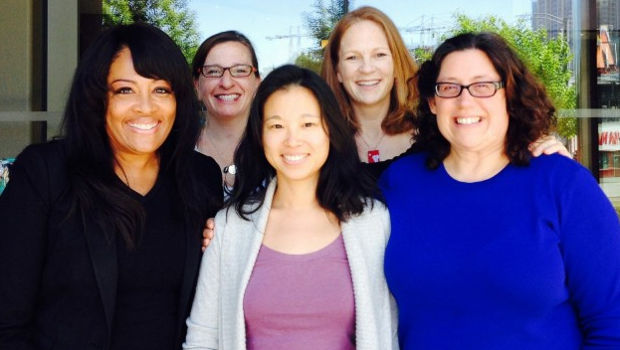How to boost rates of cancer screening among Latinas and Black women?

Just a few of members of this research team (L-R): Camille Campbell, Susan Brandzel, Eva Chang, Diana Buist, and Nora Coronado.
Group Health patients suggested several potential solutions to Susan Carol Bradford and colleagues
Susan Carol Bradford, MS, is Group Health’s manager of screening and outreach programs and a clinical associate at Group Health Research Institute (GHRI).
For Latinas and African American women, rates of death from some of the most common cancers continue to be higher — while rates of screening among these groups are lower — than for other Americans. That’s why our research team conducted focus groups with Group Health patients from these communities.
We wanted to better understand their preferences about cancer screening reminders and what motivates them to receive recommended screening for breast, cervical, and colon cancer — and what gets in their way. We published “Latina and Black/African American Women’s Perspectives on Cancer Screening and Cancer Screening Reminders” in the Journal of Racial and Ethnic Health Disparities.
The six two-hour focus groups with 39 participants surfaced a variety of suggestions for how to boost screening rates for Latinas and Black women. Examples included: improving understanding about the benefits of cancer screening; clarifying cancer screening guideline recommendations; raising diversity and cultural competency among health care professionals; making costs more transparent; and offering cancer screening at expanded locations and times (like evenings and weekends).
“This collaboration is a great example of how Group Health leaders work with GHRI as part of a true learning health care system.”
— Paula Lozano, MD, MPH, Group Health Associate Medical Director for Research and Translation
We found it interesting that even though all these women had insurance coverage, and most of them were strong endorsers and users of recommended cancer screening services, they still reported several barriers to getting screened: lack of time, conflicting information about screening intervals, distrust in the health care system, and a lack of understanding of the benefits of preventive care.
Birthday letters
Group Health has a long history of systematically reminding our patients to get recommended preventive health services, including cancer screening, following evidence-based guidelines tailored to age, sex, and personal risk factors. This used to happen with a separate reminder for each service. But around a decade ago, Group Health started sending each patient a “birthday letter”: a single, consolidated, yearly reminder letter about these upcoming services around the time of their birthday.
Less is known about how best to deliver these kinds of reminders as opposed to those focusing on one screening event and one health condition at a time. Indeed, another Group Health study showed that changing from a separate reminder for Pap tests to the birthday letter was not as helpful for women who tend to get these tests regularly. So we’ve added quarterly “just-in-time” letters to remind patients about Pap and other tests — until they get those tests.
We’re particularly interested in doing all we can to make these reminders more effective. Latina women in the focus groups suggested more reminders in Spanish — and more Spanish-speaking health care staff at every care level. Some women were confused when the reminder’s recommendations about intervals between screenings clashed with what their provider told them. Some women wanted to go back to a one reminder per test, closer to the time when the test is due. But others preferred having the advance notice. Some suggested multiple reminders, including community health workers, phone calls, and texting — as long as the text included a phone number to call.
What else should we do?
Several other observations arose during the focus groups, which may warrant future research. For instance, several women said that cancer was a hidden or forbidden topic for their parents, making it difficult for them to discover whether certain diseases run in their family. “I have no clue who has what or has anything,” one woman told us. “So I’m flying blind.”
For women raised in low-income families, health care was perceived as too expensive. So it was reserved for emergencies, and preventive care seemed a new idea. Some women mistrusted health care, and one cited the Tuskegee syphilis experiment. Work and family obligations were a barrier to taking time out for screening. “The stool test is great because I can do it at home,” one woman told us.
Big thanks to all
Susan Brandzel, MPH, now at SEIU 775 Benefits Group, is our paper’s first author, and Diana S.M. Buist, PhD, MPH, is the senior author. Our coauthors are GHRI’s Leah Tuzzio, MPH, Erin Aiello Bowles, MPH, and Camille Campbell; with Eva Chang, PhD, MPH, now at RTI International in Waltham, MA; and Nora Coronado, MSW, PhC, now at the University of Washington. Hongyuan Gao of GHRI provided programming support to recruit study participants.
We’re grateful to all the study participants for taking the time to candidly share their experiences and opinions with us. The American Cancer Society (RSGI-11–100–01-CPHPS) and National Cancer Institute (U01CA63731) supported this work.
Learn more about Group Health Research Institute’s work at www.grouphealthresearch.org.


